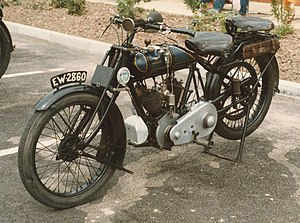Martinsyde
| Company type | Private |
|---|---|
| Industry | Motorcycle, Aviation |
| Founded | 1908 |
| Founder | H.P. Martin and George Handasyde |
| Defunct | 1922 |
| Fate | Liquidated after a factory fire |
| Headquarters | Woking and Brooklands , England |
Key people | H.P. Martin and George Handasyde |
| Products | Motorcycles, Aircraft |
Martinsyde was a British aircraft and motorcycle manufacturer between 1908 and 1922, when it was forced into liquidation by a factory fire.[1]
History[edit]
The company was first formed in 1908 as a partnership between H.P. Martin and George Handasyde and known as Martin & Handasyde. Their No.1 monoplane was built in 1908–1909 and succeeded in lifting off the ground before being wrecked in a gale.[2] They went on to build a succession of largely monoplane designs although it was a biplane, the S.1 of 1914, that turned Martin-Handasyde into a successful aircraft manufacturer.
In 1915 they renamed the company Martinsyde Ltd, and it became Britain's third largest aircraft manufacturer during World War One, with flight sheds at Brooklands and a large factory in nearby Woking.
Martinsyde Motorcycles[edit]

Martinsyde began manufacturing motorcycles from 1919 after buying the rights to engine designs by Howard Newman, which included a 350 cc single and a 677 cc V-twin with an unusual exhaust-over-inlet layout.[1]
The 680 engine was fitted into a diamond-type frame with Brampton forks. Martinsyde had to overcome problems with components before its new range could be launched, initially under the trade name of Martinsyde-Newman, until the third partner Newman left the company. (Newman was also involved in manufacturing and designing Ivy motorcycles.) The V-twin motorcycle had a hand gear change, and a three-speed gearbox built under licence from AJS. Martinsyde's engine was very flexible and became popular for off-road trials competition, where the singles quickly gained a reputation for reliability, at Brooklands, where Martinsyde won the team award in 1922, and the Scottish Six Days Trial.[1]
Martinsyde motorcycles were offered with sidecars and the Martinsyde 680 was followed by a 500 cc model in 1920, with a sports version in 1921. In 1922 Martinsyde produced a 738 cc sports V-twin, named the Quick Six which produced 22 horsepower (16 kW) and was capable of 80 miles per hour (130 km/h). The engine featured the company's normal overhead exhaust and side-valve inlet, but with Ricardo pistons, accurately balanced flywheels, all reciprocating parts lightened, nickel steel con-rods machined all over, and close ratio three speed gearbox.[3] Martinsyde was experimenting with new designs, including valve gear controlled by leaf springs, when its Woking factory was destroyed by a fire in 1922, forcing the company into liquidation after produced over 2,000 motorcycles. Martinsyde's motorcycle manufacturing rights were purchased by Bat Motor Manufacturing Co. Ltd, which produced a number of twin-cylinder motorcycles in 1924 and 1925 before ending production.[1]

Martinsyde aircraft[edit]

Martinsyde-designed aircraft included:
- Martin-Handasyde No.3 – sports aircraft, 1910
- Martinsyde S.1 – single-seat scout, 1914
- G100 and G102 "Elephant" – scout aircraft 1915 onwards, 171
- Martinsyde RG
- Martinsyde F.1
- Martinsyde F.2
- Martinsyde F.3 – private venture design with the Rolls-Royce Falcon engine, only a few produced due to lack of available engines
- Martinsyde F.4 Buzzard – fighter, the F.3 with a Hispano-Suiza engine
- Martinsyde Semiquaver – racing aircraft
A number of surplus Buzzard airframe were later built up with a new engine, the radial Armstrong Siddeley Jaguar, by the Aircraft Disposal Company (ADC) and sold as the "Martinsyde ADC.1" in 1924. A development of the F.4 was also made by the ADC: two "ADC Nimbus" were produced as prototypes. The company also manufactured the BE.2c and S.E.5a aircraft under sub-contract.
References[edit]
- ^ a b c d "Martinsyde Quick Six". Archived from the original on 27 May 2013. Retrieved 2 January 2009.
- ^ British Aircraft Before the Great War, Michael H. Goodall & Albert E. Tagg, p. 187
- ^ "A New Sports V-Twin", Motor Cycle, May 11th 1922, p599
External links[edit]
 Media related to Martinsyde at Wikimedia Commons
Media related to Martinsyde at Wikimedia Commons- List of all Aircraft made by Martinsyde Ltd


 French
French Deutsch
Deutsch